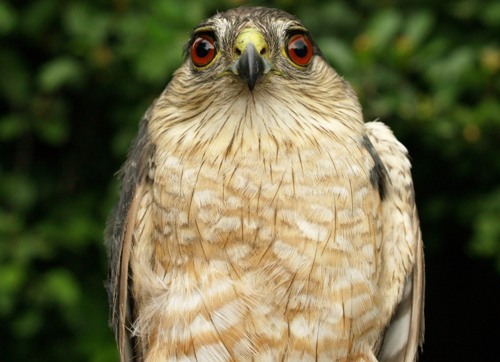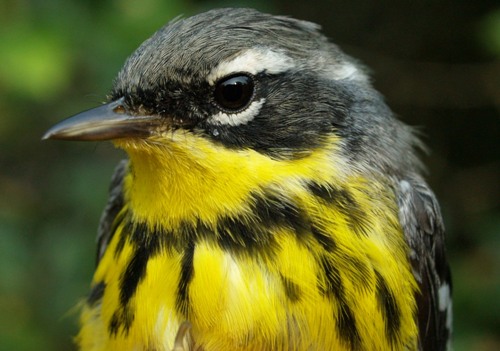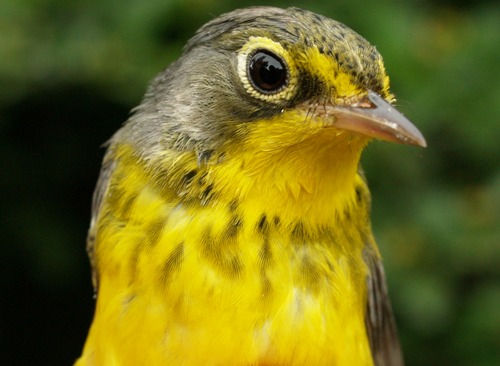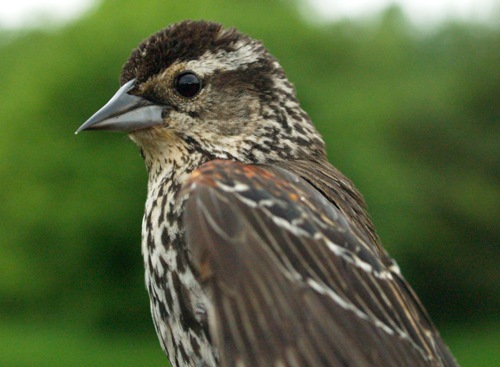|
|
THIS WEEK |
THIS SPRING |
2009 TOTAL |
SITE TOTAL |
|
# birds (and species) banded |
32 (17) |
628 (59) |
751 (61) |
24260 (105) |
|
# birds (and species) repeat |
9 (5) |
161 (26) |
191 (26) |
4532 (66) |
|
# birds (and species) return |
3 (3) |
113 (24) |
122 (26) |
742 (37) |
|
# species observed |
58 |
137 |
140 |
200 |
|
# net hours |
156.0 |
3115.4 |
3181.4 |
43088.6 |
|
# birds banded / 100 net hours |
20.5 |
20.2 |
23.6 |
56.3 |
|
|
Note: table does not include nocturnal banding (owls) |
Bander-in-charge: Simon Duval
Assistants: Mike Beaupré, Christine Burt, Rejean Duval, Jeff Harrison, Malcolm Johnson, Barbara MacDuff, Chris Murphy.
Notes: The banding results this week look particularly meager, but that's largely because in the final week of spring migration monitoring we only have the nets open for the first three days, limiting ourselves to census observations thereafter since by early June most birds in the area are residents, with only a few late migrants trickling through (and all the more so in a year like this where spring was early). On top of that we lost one of our banding days to rain. However, the relatively slow week provided an opportunity to prepare for our second year of participation in the MAPS (Monitoring Avian Productivity and Survivorship) program, a means of tracking our local birds.
Again this week the number of species observed was a record low, 58 compared to between 70 and 84 in previous years. Given that migration was advanced this spring, it's no surprise that the only new species observed in this final week of the season was Alder Flycatcher (which in reality probably arrived earlier, since we had recorded Traill's Flycatcher last week ... it's just that we didn't hear one vocalizing to clinch the identification until this week). The only new species banded this week was a Sharp-shinned Hawk, bringing the season total to 59 species, the lowest in our six years of spring migration monitoring. Similarly, the total of 628 individuals banded is a record low. We will need to look at the numbers more closely, but our initial speculation is that these totals reflect the unusually early movement of some species through the area prior to the start of our season combined with the unseasonally hot temperatures in late May that likely inspired later migrants to continue north more rapidly than in other years.

The 59th species banded at MBO this spring, and the only raptor caught this season, this Sharp-shinned Hawk was a pleasant surprise in week 10.
(Photo by Simon Duval)
|
With so few birds banded this week, the top ten list is more of a top six, as the remaining 11 species were all tied with just one individual each. Cedar Waxwings topped the week 10 list for the fourth time in six years; the species that was number one in the other years, Blackpoll Warbler, was among those banded just once this week. Somewhat surprisingly this is the first time that Yellow Warbler has made the top ten list for the final week of spring - it isn't that they aren't usually around at this time, just that usually we have banded all of the local residents earlier in the season (if not in past years).
This week's
top 10 [last week's rank in brackets] |
#
individuals banded |
mean #
individuals observed daily |
1. Cedar Waxwing (8) [1] |
1. Red-winged Blackbird (22) [2] |
2. Red-winged Backbird (4) [6] |
2. Cedar Waxwing (12) [3] |
3. Yellow Warbler (3) [-] |
3. Tree Swallow (10) [5] |
4. Tree Swallow (2) [-] |
4. Ring-billed Gull (8) [7] |
4. Magnolia Warbler (2) [-] |
5. American Crow (8) [4] |
4. Baltimore Oriole (2) [-] |
6. Yellow Warbler (7) [8]
|
7. 11 species tied (1) |
7. Baltimore Oriole (6) [10] |
| |
8. Song Sparrow (6) [-] |
| |
9. American Goldfinch (6) [6] |
| |
10. Cliff Swallow (5) [1]
Black-capped Chickadee (6) [-]
House Wren (6) [-] |
|
Among the species observed, Red-winged Blackbird was on top by a large margin, as has been the case every year in week 10. Cedar Waxwing is always in the top ten at this time of year, but this is the first time it has ranked so high. Meanwhile, House Wren appears on the list for the first time in spring. Overall it was a slower than usual spring, and a bit disappointing in that we never got the big push of migrants we were anticipating. However, as the weekly reports have shown, we still enjoyed plenty of highlights. We now switch over to monitoring our breeding bird population for the next two months before resuming migration monitoring at the beginning of August.
|

The second-last day of spring banding provided a nice opportunity to compare two of our "necklaced" warblers - female Magnolia above, and female Canada below.
(Photos by Simon Duval)

|




